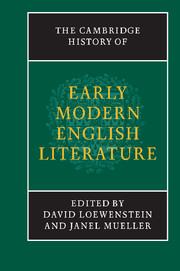Book contents
- Frontmatter
- Introduction
- 1 Modes and means of literary production, circulation and reception
- 2 The Tudor era from the Reformation to Elizabeth I
- 3 The era of Elizabeth and James VI
- 10 Literature and national identity
- 11 Literature and the court
- 12 Literature and the church
- 13 Literature and London
- 14 Literature and the theatre
- 4 The earlier Stuart era
- 5 The Civil War and Commonwealth era
- Chronological outline of historical events and texts in Britain, 1528–1674, with list of selected manuscripts
- Select bibliography (primary and secondary sources)
- Index
- References
11 - Literature and the court
from 3 - The era of Elizabeth and James VI
Published online by Cambridge University Press: 28 March 2008
- Frontmatter
- Introduction
- 1 Modes and means of literary production, circulation and reception
- 2 The Tudor era from the Reformation to Elizabeth I
- 3 The era of Elizabeth and James VI
- 10 Literature and national identity
- 11 Literature and the court
- 12 Literature and the church
- 13 Literature and London
- 14 Literature and the theatre
- 4 The earlier Stuart era
- 5 The Civil War and Commonwealth era
- Chronological outline of historical events and texts in Britain, 1528–1674, with list of selected manuscripts
- Select bibliography (primary and secondary sources)
- Index
- References
Summary
A vast machine – teeming with people and abuzz with opportunity – the royal court in the Elizabethan period was a centre of political happenings, a cultural nexus and a powerhouse of literary activity. Much of that literature came from the top. As the seat of government and as home to the monarch, the court generated a whole promotional literature – public speeches and sermons, official histories and prayers, carefully staged processions and executions, state-sponsored pageants and shows – designed to disseminate power and to maintain civil order by cowing foreign ambassadors and the native populace alike. But the court was also a place where literature came up from below and where writing enabled men to work their way up to what Sir Thomas Wyatt had called ‘the slipper top/Of court’s estates’. Under the guise of entertaining the court with music, poetry, tournament and dance, upwardly mobile courtiers – and the equally ambitious men in their employ – used literature as a direct way of getting themselves noticed and of advancing their own personal or political cause. Above all else the court was a public space – a place for display and showing off – where all aspects of the drama were cultivated, developed and exploited to the full. But it was also the place where some of the period’s most private and intensely introspective poetry was written. The court was an exclusive preserve of aristocratic privilege, a rarified coterie setting in which courtiers amused each other by imitating poetic models then fashionable on the continent and circulating them privately in manuscript among themselves.
- Type
- Chapter
- Information
- The Cambridge History of Early Modern English Literature , pp. 343 - 373Publisher: Cambridge University PressPrint publication year: 2003

